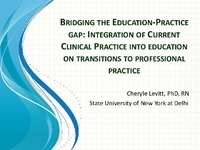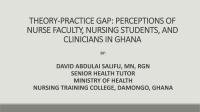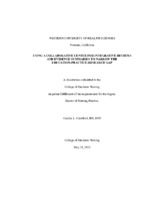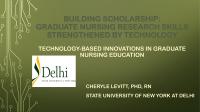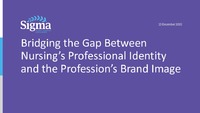| dc.description.abstract | <p>Session presented on Monday, July 28, 2014:</p>
<p><strong>Purpose:</strong> There is an acknowledged gap between the content in undergraduate nursing education programs and the expected performance standards and roles of nursing in the healthcare setting. The continual changes in the healthcare system are not sufficiently reflected in basic nursing education, and the gap results in graduates that may not be sufficiently prepared for the current role expectations for nurses in various settings. Nursing education is charged with preparing graduates to integrate into reconceptualized roles that include areas such as collaboration, leadership, quality management, use of technology, and care management. The Institute of Medicine study on the Future of Nursing (2011) identifies this gap as an issue for improvement for nursing education in order to create an effective transition for graduate nurses to a range of practice settings. To address this, faculty in a RN-BSN program contacted clinicians in various healthcare settings to seek their input for topics to guide course development, in order to provide an opportunity for a direct connection from the field into the classroom. This descriptive study sought to bridge this gap by providing suggestions directly from practitioners in the field to contribute to course development in an online RN-BSN program, for a core course in transitions to professional practice. The study queried practitioners for the content topics they deem essential for nursing students to learn, in order to transition into professional nurses. A secondary purpose was to reveal and identify differences between clinicians vs. faculty recommendations for areas of content.</p>
<p><strong>Methods:</strong> This study, approved by the university IRB, collected information via an electronic survey, from experienced BSN and MSN nurses (93% with > 5 years experience) in a diverse selection of roles and clinical areas, faculty currently teaching in a RN-BSN program, and graduates of a RN-BSN program. Clinical roles of participants included staff, preceptors, managers, and administrators in acute care facilities, both rural and metropolitan, in teaching and community hospital settings, long term care, and outpatient settings. Participants (total respondents: n=206) were asked to identify and prioritize, from a list of topics provided, the pertinent content areas to include in a core foundational course for transition to the roles of professional nursing. Topics were selected using standards for professional practice, evidence from the literature, and texts on professional practice. Participants were invited to add their own content ideas and further suggestions for the subject areas of the course.</p>
<p><strong>Results:</strong> Results were analyzed with descriptive statistics and for differences, using a series of Kruskal Wallis tests. The survey was piloted prior to distribution. Participants were asked to choose their top ten topical areas and to rank them in order of priority. The top content areas were: accountability and autonomy; collaboration and coordination in caring; critical thinking, clinical reasoning; ethical principles and standards; evidence based practice; informatics and technology; leadership and management; professional communication; professional nursing concepts; quality improvement. No significant differences in mean importance rankings for any of the nursing curriculum topics were found according to age. A significant result was found for history of nursing (?=7.846, 2 df, p=.020) where it was found to be at the bottom of the ranked list, for leadership and management principles (?=14.061, 5 df, p=.029), for critical thinking, clinical reasoning (?=8.790, 2 df, p=.012) and for professional nursing concepts: philosophy, identity, standards, roles, behaviors (?=6.213, 2 df, p=.045). No significant differences in mean importance rankings were found according to highest degree earned by the participant, for geographic location, between rural and metropolitan groups, according to clinical setting, or between clinicians, faculty, and recent graduates. Significance for excluding nursing history, previously in the course, was highest among less experienced nurses.</p>
<p><strong>Conclusion:</strong> The results identified priority content areas, that were combined with standards for baccalaureate education, and applied directly into course development for a core transitions to professional nursing course, as well as integrated into other courses within the program. The course was developed and launched within 4 months of the results of the study, thus providing rapid utilization of the results. The study sought to help to prepare nurses with realistic content that can assist them to be effective practitioners in the present and future healthcare environment, to reduce a gap between education and practice, and to provide faculty with the pertinent content to enable this outcome. The congruence in results between clinicians and faculty was gratifying. The faculty felt that the course was the most current possible, and was supported by clinicians who would likely be working with graduates of the program at a future date. It is recommended to use this collaborative approach for development of other courses in the baccalaureate curriculum.</p> | en |
